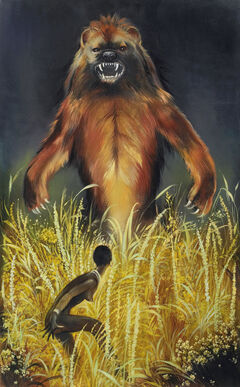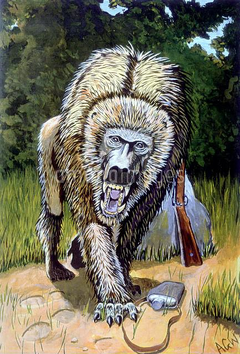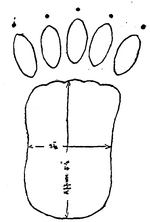| ||||||||||||||
The Nandi bear or chemosit (Kalenjin: "devil"[1]) is a cryptid reported from the highlands of western Kenya, as well as Uganda,[1][2][3][4] described as a dangerous animal resembling a bear with a shaggy mane.[5][6]
Various different cryptids have been lumped together under the name of Nandi bear, and cryptozoologists have identified it as an amalgamation of various animals,[7] including perhaps two genuine unknown animals: a giant hyena and a giant baboon, although identities of a living chalicothere and an unknown bear have also been suggested.[2][1][8] There have been few or no sightings since the 20th Century, and it has been suggested that the Nandi bear, if it existed, is now extinct.[9]
Etymology[]
The Nandi bear is named for the Nandi people who live around Kapsabet, an area where the animal was frequently seen. Geoffrey Williams, one of the first eyewitnesses, compared the animal he saw to a bear, and the name stuck.[1] However, prior to the 1930's the name "chemisit" or "chemosit" seems to have been more commonly used. In the first decades of the 20th Century it was often referred to simply as the unknown or unidentified animal of the Uasin Gishu, and later of the Magadi Railway.
A number of oddly-similar names have been applied to the large hyenas which seem to be the Nandi bear by different authors, including "giant forest hyena," "brown forest hyena," and "long-haired brown forest hyena". "Giant forest hyena" was first used to refer to the so-called Mubende monster in 1937, and was later used by the hunter McLeod in 1962, then applied by Nairobi zoologists to the giant hyenas shot by Douglas Hutton in 1981. "Brown forest hyena" or "long-haired brown forest hyena" was the name used by Angus Hutton and Louis S. Leakey to refer to the large hyenas shot by Angus Hutton in 1960. Despite being utilised by the afformentioned zoologists as if they were well-known common names, none of these names are known to have been used anywhere else.
Description[]
According to Bernard Heuvelmans, the sightings which cannot be explained by mistaken identity all conform to a single description of an animal with a "(1) thick stocky body, (2) high withers, sloping back, (3) forequarters covered with thick fur, hindquarters smoother and barer, (4) long rather pointed snout, (5) small ears, (6) no visible tail, colour tawny to dark brown".[2]
According to some other cryptozoologists, the animal referred to as the Nandi bear actually seems to be more than one cryptid.[1][10] As early as 1914, Blayney Percival wrote that the Nandi animal and the Magadi Railway animal were different and should not be confused,[4] and animals such as the shivuverre and the chimiset, which have been brought together under the label of "Nandi bear," do appear to be distinct. George Eberhart seperates the Nandi bear into two main cryptids: a large, baboon-like beast, and a hyena-like creature. He offered descriptions of both versions:[1]
- The hyena-like animal is twice the size of a spotted hyena, with shaggy brown hair and a short head displaying red eyes, small ears, and large teeth. It has a long mane on its forequarters and a sloping back and forelegs longer than its hindlegs. It has a short tail. It leaves spade-shaped digitigrade tracks larger than those of a man, with three toes and huge, inward-turned claws, and pads.[1]
- The baboon-like version is a thickset animal, 3 feet 6 inches to 4 feet 6 inches at the shoulder, and 4 to 5 feet when standing on its hindlegs. It is dark brown or tawny, with long shaggy hair and a long head similar to that of a bear joine to a short neck, displaying small ears, a stumpy nose, and a pointed snout. Its front area, shoulders, and front legs are thickly furred, whilst the hindquarters are relatively bare. The withers are high and the back is sloping, and the tail is small or nonexistent. It leaves oblong plantigrade tracks 5.5 inches long and and 3.5 inches wide, displaying five clawed toes.[1]
Huevelmans also noted the difference between the tracks of the Magadi Railway animal and those of the animal which took Captain William Hichens' dog.[2]
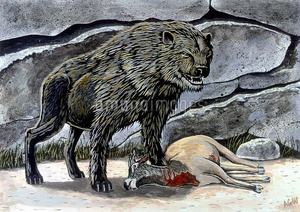
The "giant forest hyena" concept of the Nandi bear, as drawn by Anthony Wallis.
The Nandi bear rests on its haunches like a true bear, is described as having a loping run or "sideways canter", also almost like a bear, and the baboon-like variety is capable of standing upright[2] but other than this, as the only detailed accounts of encounters with the animal are brief, most information on the Nandi bear's behaviour must come from native testimony. It is described as aggressive and highly dangerous, killing livestock and animals, which it will climb, leap, or force its way through[2] fences and thorn zarebas to get to. It is also said to force its way into huts during the night to kill the occupants. Various native sources as well as Captain Hichens describe its "terrifying howl" or "moaning call". Perhaps most notably, it is said to tear or smash open the heads of livestock and humans to eat their brains.[1] Captain Hichens wrote that the Nandi bear waits in trees near roads to waylay travellers and rip their heads open, and attacks and takes away women washing clothes so often that many women will not go down to the river without armed men.[11] Captain Hichens also noted its habit of forcing its way through 6-foot thorn zarebas (mentioned above), something which he had never known even man-eating lions or leopards to do.[12][note 1]
It is also generally regarded as a nocturnal animal, hunting and attacking during the night. In all of the sightings made during the day or the morning, the animal runs away or ignores the eyewitness; whilst in nocturnal encounters it often displays aggressive behaviour, even attacking some eyewitnesses (or their dogs).[2]
The Nandi bear is mainly reported from the forested regions of the Uasin Gishu plateau and the Nandi Hills, especially near Kapsabet and Kapsowar.[1] According to John Ford, it is also reported from Uganda's Mount Elgon,[13] and it has apparently been reported from Rwanda.
Physical evidence[]
Specimens[]
At least four alleged Nandi bear specimens have been collected and sent to museums over the years, but all have unaccountably disappeared. The first specimen was the "huge lynx-like creature" shot in 1936 in the Mau Forest by Jesse R. Coope, the skin and skull of which was sent to the British Museum, only to disappear.[14][15] The second and third specimens were the "giant forest hyenas" shot on the Chemomi Tea Estate by Douglas Hutton, the bones of which were sent to the Nairobi Museum.[16][1]
Tracks[]
As mentioned above, descriptions of Nandi bear tracks are common, but the tracks themselves have never been photographed, and were only drawn once, when Fritz Schindler sketched a track (1) found in mud near the Magadi Railway which had been seen by several native workers. It was said to have been made by an unknown large animal, and is identified with the baboon-like version of the Nandi bear. According to Bernard Heuvelmans, the track resembles two ratel prints, one superimposed upon the other.[2]
Sightings[]
Undated • 1905 • c. 1910's • 1912 • 1913 • 1914 • 1923 • 1925 • c. 1927 • c. 1930's • 1936 • 1941 • 1957 or 1958 • c. 1960's • 1962 • 1967 • 1981• 1998
Undated[]
In 1905, the Nandi people allegedly told Richard Meinertzhagen that the Nandi bear was common when the Nandi first settled in the highlands of what is now Kenya, which occured in or around the early 17th Century.[17][note 2] It was said to have been pushed to the brink of extinction by the rinderpest epidemic at the end of the 19th Century, which decimated the populations of various ungulates including the then-cryptozoological giant forest hog.[1] Although it was never abundant, it was not uncommon before the epidemic, from which the population never recovered.[18] During the colonial era the Nandi bear was blamed for the allegedly "hundreds" of natives who were found dead with their skulls crushed every year, probably the victims of hyenas. It was widely feared by native people, but it does not seem to have been known to Europeans or colonial officials until the turn of the century.[2]
Captain Hichens wrote that:
| “ | one of the best accounts is that of Major Braithwaite and Mr. C. Kenneth Archer, two well-known Kenya colonists, whose experience and word are not lightly to be imputed in such matters. They saw the animal in grass and scrub and took it for a lioness; later, a side-view of its head gave the impression of a snout, the head being very large, while the beast stood very high forward, 4 ft. 3 ins. to 4 ft. 6 ins. at the shoulder. "The back," they say, "sloped steeply to the hindquarters and the animal moved with a shambling gait which can best be compared with the shuffle of a bear. The coat was thick and dark brown in colour. Finally, the beast broke into a shambling trot and made for a belt of trees near the river, where it was lost.[12]
|
” |
Some years before 1912, the Nandi killed a shivuverre after it climbed onto the roof of a hut, broke through, and killed everyone inside. The people of the village burned down this hut with the animal inside.[19] Geoffrey Williams heard of a preserved skin of a similar animal in Kabras, but was unable to obtain it.[19]
C. W. Hobley heard a rumour that a Nandi bear had been shot by a Boer, who left the carcass and couldn't find it again.[20] Similarly, a Uganda farmer named K. R. Williams was said to have accidentally killed a young Nandi bear with poisoned bait set out for hyenas: "it was much larger than a spotted hyena, though it had the same dirty yellow fur. Its head was just like a bear's." Williams returned to his camp to fetch a knife for skinning the carcass, but in his absence it was dragged away by actual hyenas.[2]
A Nandi claimed that one had been shot dead with a poisoned arrow in a forest by a "Dorobo" man, then seen by the Nandi and his friends. The Nandi described the carcass as having a "shape like a hyaena with longer legs (heavy forequarters)," "size like a great dane," a forehead "like a man (short-haired)," "ears smaller than a hyaena and round," a nose "long like a dog, but not heavy," teeth "longer and bigger than a lion," "hair long, black, soft," a mane "all the way down its back, also had a shaggy beard," a tail "like a donkey," "feet not very big," and "claws like a dog, but the size of an antbear," or aardvark. Although he only saw its body, the Nandi said that it sat like a monkey.[21]
At some point shortly before 1918, a "gadett" (geteit) appeared on the farm of Cara Buxton, where ten sheep were missing. All ten were found, seven dead and three alive, and all of them without brains. Over the next ten days the same thing happened to fifty-seven goats and sheep, of which thirteen were found alive. The locals in the area described the culprit as a beast which walked on two legs, snatched babies, and killed men. Eventually it was tracked to a ravine and speared to death, whereupon it was discovered to be a very large spotted hyena. "It had evidently turned brain-eater through some sort of madness".[22] However, Heuvelmans writes that it is not completely proven that the slain animal was the culprit.[2]
Charles Stoneham saw what his friends believed was a Nandi bear near the Kipsanoi River in Sotik. He described it as being the size of a lion but moving differently, with a pig-like snout, and an enormous tail the size of a tree trunk. Its ears were large, circular, and transparent.[23] He rushed indoors to grab a rifle, but by the time he returned the animal was fleeing.[1] Although his friends said he must have seen a Nandi bear, he himself believed it was some form of mutant or hybrid aardvark.[2]
Ivan T. Sanderson wrote that there was a brown shaggy skin in London's Natural History Museum which may have belonged to the Nandi bear.[2]
A settler in the Trans-Nzoia claimed to have been attacked by a Nandi bear which broke down the door of his hut:
| “ | The creature broke down the door to get at him, and was, he said, about eight feet high and like a grey polar bear. This terrible creature, its red eyes blazing and jaws slavering, went straight for the man, and a chase round the table followed. Luckily, however, the man managed to grab a revolver that was hanging on the wall and fire into the animal's chest, at which it turned and, growling horribly, made out through the doorway and off.[24]
|
” |
Whilst hunting in a forest in Kenya, Roger Courtney was shown a pair of enormous tracks like those of a hyena, but splayed inwards and the size of dinner-plates. He believed they were bear tracks due to their size and because they were turned inwards.[24]
J. K. Jackson referred to a striped, long-fanged animal seen by workers in the Imatong Mountains of South Sudan as a "Nandi bear" - which he believed was an abberent hyena - but it is more likely that this animal could have been a tigre de montagne.[25]
1905[]
The first recorded sighting of the Nandi bear was made in 1905 by Geoffrey Williams, who was with the Nandi Expedition to the Uasin Gishu in western British East Africa. He saw a 5-foot-high animal around 30 yards away, sitting like a zoo bear, with a long head and small, pointed ears. It ran with a sideways canter.
| “ | I was traveling with a cousin on the Uasingishu just after the Nandi expedition, and, of course, long before there was any settlement up there. We had been camped ... near the Mataye and were marching towards the Sirgoit Rock when we saw the beast ... I saw a large animal sitting up on its haunches no more than 30 yards away. Its attitude was just that of a bear at the 'Zoo' asking for buns, and I should say it must have been nearly 5 feet high ... before we had time to do anything it dropped forward and shambled away towards the Sirgoit with what my cousin always describes as a sort of sideways canter. I snatched my rifle and took a snapshot at it as it was disappearing among the rocks, and, though I missed it, it stopped and turned its head round to look at us ... In size it was, I should say, larger than the bear that lives in the pit at the 'Zoo' and it was quite as heavily built. The fore quarters were very thickly furred, as were all four legs, but the hind quarters were comparatively speaking smooth or bare ... the head was long and pointed and exactly like that of a bear ... I have not a very clear recollection of the ears beyond the fact that they were small, and the tail, if any, was very small and practically unnoticeable. The color was dark...[19]
|
” |
This sighting was not published until 1912.[2]
Ricky Ngeny of the Koitalel Samoei Nandi Foundation suggested that the body of Koitalel, a Nandi leader assassinated by Richard Meinertzhagen in 1905, was eaten by a Nandi bear.[26]
circa 1910's[]
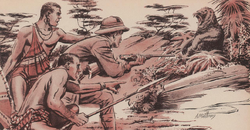
Illustration by A. McWilliams of a hunter encountering the Nandi bear, from the December 1961 Boys' Life annual.
During the surveying of the area where the Magadi Railway was to be built, Clifford Hill's Dutch boy encountered a large animal on the Koora Plains. He was unable to describe it, but when shown a book of animals, he selected the bear as being the most like the animal he had seen.[27]
A sub-contractor, Mr. Caviggia, saw the animal along the Magadi Railway track. His description tallied with that of G. W. Hickes (see below).[27]
C. W. Hobley wrote that several workers during the construction of the Magadi Railway saw the tracks of a strange animal in the muddy ground around a water outflow. Fritz Schindler saw and sketched this track.[20]
1912[]
In 1912 a Major Toulson encountered a long-haired black beast on the Uasin Gishu, which had just attempted to raid his camp's kitchen. It ran with a shuffling walk and was around 18 to 20 inches at the shoulder.[1] He later described his encounter to anthropologist C. W. Hobley:
| “ | It was getting dark when one of my boys came into my room and said that a leopard was close to the kitchen. I rushed out at once and saw a strange beast making off: it appeared to have long hair behind and was rather low in front. I should say it stood about 18 in. to 20 in. at the shoulder; it appeared to be black, with a gait similar to that of a bear--a kind of shuffling walk. Unfortunately it was nearly dark at the time and I did not get a fair view of the head.
Several Dutchmen had asked me a few days before what the strange animal was on the plateau; they said it was like a bear, but they had only seen it at dusk; it turned on their dogs and chased them off. They described it as a thick-set beast and it was making a peculiar moaning cry.[20] |
” |
1913[]
There were two sightings of the Nandi bear in March 1913. The first of these, which lacks a specific date, was made by N. E. F. Corbett, the District Commissioner of Eldoret in British East Africa:
| “ | I was having lunch by a wooded stream, the Sirgoi River, just below Toulson's farm ... to my surprise I walked right into the beast. It was evidently drinking and was just below me, only a yard or so away ... it shambled across the stream into the bush ... [I] could not get a very good view, but am certain that it was a beast I have never seen before. Thick, reddish-brown hair, with a slight streak of white down the hindquarters, rather long from hock to foot, rather bigger than a hyena, with largish ears. I did not see the head properly; it did not seem to be a very heavily built animal.[20]
|
” |
The second sighting, perhaps the most famous, was made by railway engineer G. W. Hickes at around 9 A.M. on 8 March. He observed the animal from 50 yards away. Whilst travelling on a motor trolley he saw what appeared to be a hyena straight ahead. Wondering why a hyena would be out so late in the morning, he looked closer:
| “ | It was almost on the line when I first saw it and at that time it had already seen me and was making off at a right angle to the line ... As I got closer to the animal I saw it was not a hyena. At first I saw it nearly broadside on: it then looked about as high as a lion. In color it was tawny--about like a black-mained [sic] lion--with very shaggy long hair. It was short and thickset in the body, with high withers, and had a short neck and stumpy nose. It did not turn to look at me, but loped off--running with its forelegs and with both hind legs rising at the same time. As I got alongside it, it was about forty or fifty yards away and I noticed it was very broad across the rump, had very short ears, and had no tail that I could see. As its hind legs came out of the grass I noticed the legs were very shaggy right down to the feet, and that the feet seemed large...[27]
|
” |
Hickes realised afterwards that the animal was the unknown "bear" which had been seen, and considered stopping to pursue the beast, which he could still see in the distance, before remembering that the other engineers were waiting for him. He intended to return to the spot during the return journey to examine the tracks, but they were washed away by rain.[27]
Not long afterwards a native servant of another engineer, Mr. Archibald, saw an animal very much like the one described by Hickes, but standing on its hind legs. It stared the servant down and refused to run away.[5][27]
1914[]
A Nandi bear is said to have been killed near the heavily-forested Kapsowar in around 1914. After it killed several people,[2] villagers tricked it into attacking a dummy man in the doorway of a hut, then shot it to death with arrows. Eberhart writes that this happened in 1914; Blayney Percival, himself writing in 1914, described it as happening "fairly recently".[1][4]
1923[]
According to newspaper reports in July 1923, an American sportsman named J. Herman Burge shot and killed an animal (incorrectly described by some sources as a cat) believed to have been a Nandi bear. According to the reports, the animal appeared outside Burge's camp one morning, and was shot whilst charging one of his party. It was described as "a species of giant man-eating hyena of a strength and bulk unheard of, and with jaws as powerful as a lion's. The skin is stripped like an ordinary hyena's, but unlike that animal, its hind and fore-quarters are of an equal height. It has a mane of long, stiff bristles, which are capable of being erected to form a terrifying fringe to the massive face."[7]
1925[]
In 1925 Captain William Hichens was sent out to investigate depredations made by the animal in a village in the Kenya Colony. The latest victim was a 6-year-old girl, snatched after the monster forced its way through an 8-foot zareba.[23] During the night his tent was attacked by something which gave a terrifying roar and carried off his pet dog:[1]
| “ | ...the whole tent rocked; the pole to which Mbwambi [his dog] was tied flew out and let down the ridge-pole, enveloping me in flapping canvas. At the same moment the most awful howl I have ever heard split the night. The sheer demoniac horror of it froze me still...I heard my pi-dog yelp just once. There was a crashing of branches in the bush, and then thud, thud, thud, of some huge beast making off. But that howl! I have heard half a dozen lions roaring in a stampede-chorus not twenty yards away; I have heard a maddened cow-elephant trumpeting; I have heard a trapped leopard make the silent night miles a rocking agony with screaming, snarling roars. But never have I heard, nor do I wish to hear again, such a howl as that of the chimiset. A trail of red spots on the sand showed where my pi-dog had gone. Beside that trail were huge footprints, four times as big as a man's, showing the imprint of three huge clawed toes, with trefoil marks like a lion's pad where the sole of the foot pressed down. But no lion ever boasted such a paw as that of the monster which had made that terrifying spoor.[11]
|
” |
Hichens followed the tracks and spent a week in the forest searching for the animal, but never found it or his dog.[6]
According to the Kikuyu, an enormous hyena the size of a lion was killed at Tuso in 1925, having been speared ten times.[14][28]
circa 1927[]
An unknown animal believed at the time to have been a giant hyena killed twelve cattle near Tuso in or shortly before 1927. It killed its prey by savaging the shoulder, close to the ribs and the heart.[14][28]
circa 1930's[]
Captain F. D. Hislop, district commissioner of Kapsabet, saw a bear-like animal 3 feet high at the shoulder, with a small pointed head. It ran off on all fours. Hislop was sure that the animal was neither a hyena or a baboon.[1][29]
Also in the 1930's, Gunnar Anderssen reported that an unknown animal had killed a forest hog at Kaimosi. The animal was described to him by locals as "very big, with long black hair and a long tail carried like a dog's".[29] Anderssen also discovered some ambigious, leopardlike tracks nearby.[1]
Heuvelmans equated the Nandi bear with the khodumodumo,[2] an unseen animal which carried away livestock in South Africa during the 1930's, attacking silently and leaving round tracks with 2-inch claw-marks. Posses tried to catch the beast, but nobody ever caught a glimpse of it.[12]
1936[]
In 1936, Kenya settler Jesse R. Coope shot a "huge lynx-like creature" whilst hunting in the Mau forest. The slain animal, which was seen by Chief Game Warden of Kenya A. T. A. Ritchie, supposedly resembled a giant lynx, but had dark mahogany coloured fur. It was believed by locals to be a Nandi bear, which had been sporadically reported from the area for twenty years. The skin and skull of the animal where sent to the Natural History Museum in London, but disappeared.[14][30]
1941[]
A military officer stationed at Nanyuki reported a sighting of an animal believed to have been the Nandi bear on 12 June 1941. He saw the animal clearly in his headlights whilst driving down the Loldaikas road, near "Mr. Payne's farm," and was able to get a good look at it. As he described it, this animal differed from other reported Nandi bears in that its hindquarters, not its forequarters, were shaggy, and its back did not slope:
| “ | At the first glance my impression was definitely a bear-like animal, with a large and powerful head. It was the size of a calf, heavily built and with large feet, the latter feature being especially noticeable. The general colour was brown, and the coat was smooth over the front part of the body. The hinder parts were more shaggy. I particularly noticed that the body did not fall away towards the hind quarters — rather the reverse — if anything. I did not notice any tail. When the creature moved off the road, it appeared to shamble rather than trot or canter.[31]
|
” |
1957 or 1958[]
Douglas Hutton shot two animals on the Chemomi Tea Estate in Kenya's Nandi Hills in either 1957 or 1958. They stood 3 feet 3 inches at the shoulder and had sloping backs and heavy manes, with short, broad heads and small ears. Hutton ran into one in his car during the night and shot both it and its companion. The bodies were layed out in the factory to be viewed by the staff, and the remains were left to be stripped to the bone by ants. One staff member described the animals as being dark with black spots, whilst another described them as grey-brown with white-tipped fur. All the men said they had never seen such a creature.[16] The bones were sent to Nairobi, where they were identified as "giant forest hyenas".[1]
circa 1960's[]
Engineer Angus McDonald was awoken in Kipkabus by an animal which invaded his hut through a window and chased him around for 5 minutes. McDonald said that it was 7' tall, with an apelike face, and ran as well on two legs as it did on four. Its tracks were round. The villagers identified it as a chemosit.[23]
1962[]
In 1962, an animal twice the size of a spotted hyena was shot by the father of hunter Jamie McLeod. It had long shaggy brown hair which was "dirty on its belly", a lion-sized skull with large carnivorous teeth, and only a very slight slope of the back. Coincidentally, McLeod referred to the animal as a "giant forest hyaena". This account was forwarded to Karl Shuker by McLeod.[9]
1967[]
A Barry Gaymer reported seeing an "extraordinary animal" about the size of a spotted hyena, with long hair and a short nose near Mayer's Farm in early 1967. He later felt certain that the animal was a long-haired brown hyena.[32]
Also in 1967, farm manager John Rowing was driving down a forest road in the Cherangani Hills when:[33]
| “ | a shaggy beast, light hair unkempt like that of an unshorn sheep, jumped onto the road ahead of us and bounded along for a short distance in the headlights of our car. From the state of its coat, we imagined that it might be a domestic dog, gone feral. The choice was between a sheep and a large dog, but none us could be sure; for, while its ears stood up like a dog’s, its coat was more like that of a sheep.
|
” |
1981[]
In July 1981, a large hyena-like animal was seen in the same area where Hutton had shot the "giant forest hyenas" in the 1950's.[1] The witnesses, who were emphatic that the animal was not a hyena, a boar, or a baboon, gave a description that tallied with that given by the Chemomi Tea Estate workers:
| “ | At one group of huts the womenfolk said that a strange animal had been around their huts but they were unable to describe it, however at a second group of dwellings an old man described how the creature had walked round his hut in the early morning and then it lopped off across his shamba and so into the next where somebody threw a rungu at it and it disappeared into the maize. His description was quite vivid and tallied with that of the old men who had seen the bodies at the tea factory. He simply said the creature was a 'nyanau' [sic], a wild animal, but it was not a 'fisi' or hyaena and he was most indignant when we suggested it could have been a baboon or pig. He knew the latter well as they destroyed his maize. He had never seen a 'nyangau' [Swahili: "dirty dog" or "bloody brute"] before. Asked what would be the reaction of dogs he replied that they would certainly not go near the creatures. Where did it live in the forest and what did it feed on? "Oh, stray cattle, sheep and goats". His imagination was running away with him but he stuck to his story of the creature walking round his hut. When the creature was first reported Ken Archer was shown a foot print which he photographed. This had been obliterated by rain at the time of my visit, so we have to await the photograph.[16]
|
” |
1998[]
The most recent known Nandi bear sighting occurred in February 1998, when engineer Dennis Burnett and his wife Marlene, driving along the Koru-Kisumu road at the base of the Nandi Escarpment in the rain, saw a large animal cross the road. After reversing the car, the pair observed the animal for about fifteen seconds. Though they initially mistook it for a bear, they soon realised it was "an enormous, shaggy hyena – like a Striped Hyena, only very much bigger".[33]
Supposed captive Nandi bears[]
In the 1930's, a 200-year-old advertisement for a menagerie in Halifax, Yorkshire, United Kingdom, was discovered, which mentioned, along with monkeys and carnivorous mammals, an animal "half and half: the head like a hyena, the hind part like a Frieseland bear". Zoologist C. H. Keeling notes that the description of the animal recalls the Nandi bear, and that whatever the animal was, it obviously wasn't either a hyena or a bear, as whoever wrote the advert was clearly familiar enough with them to make a comparison.[34] A writer to Animals & Men pointed out that this animal could have been a shaggy brown hyena, which was only formally described in 1820, a notion with which Karl Shuker agrees.[35]
Another menagerie, Mander's travelling menagerie, exhibited three animals which Keeling says resembled the Nandi bear in 1869 (earlier newspaper articles show that he was exhibiting them in England and Wales as eary as 1867). These were the "Indian Prairie Fiends": "most wonderful creatures. Head like the hippopotamus, body like the bear, claws similar to the tiger, and ears similar to the horse." According to Mander, these animals were from North America.[34] Other menagerie owners exhibited Tasmanian devils under the name of "Prairie Fiends". On the other hand, Shuker speculates that Mander's Indian Prairie Fiends could have been living ground sloths from the South American pampas.[35]
Theories[]
| Proposed identity | First proposed by | Date | Notes |
|---|---|---|---|
| Spotted hyena (Crocuta crocuta) | Specifically erythristic and/or oversied individuals | ||
| Honey badger (Mellivora capensis) | Bernard Heuvelmans | 1955 | For sightings in which the animal is described as black and relatively small |
| Brown hyena (Hyaena brunnea) | |||
| Giant brown hyena (Hyaena brunnea), called "forest hyena" | Louis Leakey | ||
| Striped hyena (Hyaena hyaena) | |||
| Aardvark (Orycteropus afer) | Bernard Heuvelmans | 1955 | For the Stoneham sighting |
| African hunting dog (Lycaeon pictus) | Bernard Heuvelmans | 1955 | For the Corbett sighting |
| Chimpanzee (Pan troglodytes) | |||
| Gorilla (Gorilla) | Bernard Heuvelmans | 2015 | |
| Giant forest hog (Hylochoerus meinertzhageni) | |||
| African civet (Civettictis civetta) | |||
| King cheetah (Acinonyx jubatus morph) | Unknown; first mentioned by Hilary Wentworth | ||
| Chalicothere | Charles William Andrews | ||
| Giant baboon | Bernard Heuvelmans | 1955 | |
| Short-faced hyena (Pachycrocuta brevirostris) | Karl Shuker | ||
| Atlas bear (Ursus arctos crowtheri) | Karl Shuker | ||
| Agriotherium africanum | Karl Shuker | ||
| Simbakubwa | Karl Shuker | 2019 | |
| Human murders |
The Nandi bear is almost certainly an amalgamation of various animals, probably including hyenas, ratels, aardvarks, and African hunting dogs, as well as at least one genuine cryptid - and, according to one theory, ritual murders carried out by witch-doctors. Bernard Heuvelmans wrote that the classification problem began when Geoffrey Williams compared the animal he saw in 1905 to a bear. When Hickes saw a similar animal, the Williams sighting came to mind, and rumours spread of a bear-like animal in Kenya, prompting others who had seen unidentified bear-like animals to come forwards.[2] As early as 1914, Blayney Percival wrote that the Nandi animal and the Magadi Railway animal were different and should not be confused.[4] The identity of the "real Nandi bear" is speculated to be a giant baboon, a giant hyena, a surviving chalicothere, or an unknown bear - or possibly any combination of those four.
Mistaken identity[]
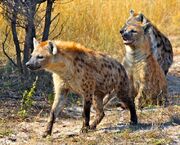
Spotted hyenas (Crocuta crocuta) have often been blamed for the Nandi bear's attacks.
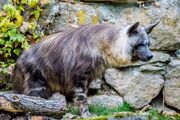
A large Kenyan variety of brown hyena (Hyena brunnea or Parahyena brunnea), referred to as the "long haired brown hyena" or "long haired brown forest hyena," may provide a good explanation for several Nandi bear sightings.
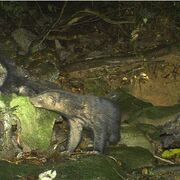
Ratels or honey badgers (Mellivora capensis) may turn completely black as they grow older and larger. Many sightings of the "Nandi bear" described as black and small may be sightings of large, unfamiliar black ratels.
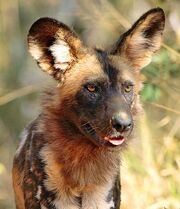
Heuvelmans believed the African hunting dog (Lycaon pictus) was the likely subject of the 1913 Corbett sighting.
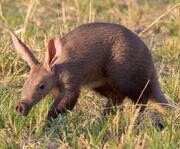
The sighting made by Charles Stoneham may have been of an aardvark (Orycteropus afer).
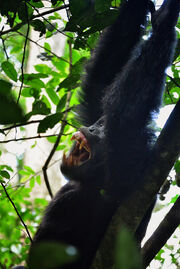
Some contemporaries thought the Nandi bear might be a chimpanzee (Pan troglodytes schweinfurthii) like those found in other parts of East Africa.
Several scientists including R. I. Pocock, Superintendent of the London Zoo, claimed that the Nandi bear was a misidentified hyena, specifically an erythristic (red) spotted hyena, which, according to some, would be fairly unfamiliar in Kenya, at least in terms of colour.[10] Pocock was sent an erythristic spotted hyena skin, along with the skull of a leopard, by a man who claimed the remains came from a Nandi bear.
However, Captain Hichens wrote that hyenas are so common around African villages that a villager confusing one with the Nandi bear would be like an Englishman confusing a rabbit with a fox. He also pointed out that hyenas drag their victims; they do not leap over 6 foot fences with calves in their mouths. Heuvelmans concluded that the Nandi bear could not be any known species of hyena on account of its size, its possession of the characteristics of different hyena species, and its habit of rearing up on its back legs, which would be very difficult for a hyena. In addition, the fact that the skull of a leopard alongside the skin of a hyena were sent to Pocock with the claim that they came from the same animal suggests that either Pocock or the man who sent the skin were the victim of a hoax.[2] However, Heuvelmans and others have noted that the "Nandi bear" could have been blamed for many killings actually carried out by hyenas.
Heuvelmans felt that it is possible for a small population of brown hyenas to have existed in Kenya, though he did not propose this as an explanation for the Nandi bear.[2]
The sightings in which the animal is described as black and relatively small are considered likely to be misidentifications of elderly honey badgers or ratels.[10][2] Honey badgers are famously aggressive, and in old age, when they are at their largest, they may turn entirely black, which would disguise their identity from eyewitnesses who would expect a honey badger to display a white or silver back, as indeed most individuals do. Heuvelmans identified a black ratel as the subject of the Toulson, Hislop, and Anderssen sightings, and thought it could explain sightings of the "too". Blayney Percival wrote that an animal reported from the Sotik country, very similar to the Nandi bear and said to be the size of a pointer, turned out to be a honey badger. Heuvelmans also suggested that these ratels, instead of having grown exceptionally large with age, could represent a larger subspecies, for which he proposed the name Mellivora ratel maxima. Heuvelmans also noted that the Magadi Railway track resembled two ratel tracks overlayed on one another. The Williams and Hickes sightings, however, obviously cannot possibly have been of ratels, as the animal described is nothing like a honey badger.[2]
Heuvelmans was almost certain that the animal seen by Charles Stoneham was an aardvark (Stoneham himself believed it was a mutant or hybrid aardvark) in light of his description of its tree trunk-like tail and round, transluscent ears: aardvarks are one of the few mammals with long, thick tails, and their ears, although not round, are notable translucent.[2] Hobley wrote that sceptics during the first wave of sightings in the 1910's believed the animal seen by Williams and Hickes to be an aardvark,[20] but, "as one researcher ever so delicately put it, aardvarks do not eat women and small children and even if they wanted to it would physically impossible".
Heuvelmans also suspected that the animal seen by Corbett, lightly-built with round ears and reddish-brown with a white streak, was an African hunting dog, which conforms exactly to Corbett's description.[2]
Richard Meinertzhagen claimed that during the coronation of Edward VII (in 1902), five men of the King's African Rifles, one of whom was a Nandi, were brought to London, where, upon seeing a chimpanzee in London Zoo, the Nandi soldier supposedly exclaimed "there is the Nandi bear!".[17][note 2] Elspeth Huxley, who spent her youth in Kenya, also wrote that some believed the Nandi bear to be a survivor of a vanished colony of chimpanzees.[36] George Eberhart also mentions the African civet and the giant forest hog as possible candidates,[1] and a king cheetah was suggested as an identity.[37]
Giant baboon[]
The giant baboon hypothesis was first suggested by Bernard Heuvelmans in On the Track of Unknown Animals (1955), although Captain Hichens had earlier written that "some of us who have hunted the brute share the view that it may be an anthropoid", and Blayney Percival wrote that "the resemblace to a monkey of sorts is very noticeable". As early as 1905, the same year as the first recorded sighting, Richard Meinertzhagen claimed to have believed that the animal was an anthropid which had recently become extinct due to infrequent rainfall.[17][note 2] The Mau, Nandi, and Wa-Pokomo people also referred to the chemosit, kerit, and koddoelo (all of which are included under the "Nandi bear" name) as enormous baboons.[2]
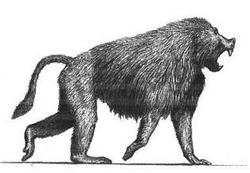
Reconstruction of the giant baboon Dinopithecus by an unknown artist. A giant baboon is a good match for the more ape-like Nandi bear, but may also be too conspicuous to exist without being discovered.
Heuvelmans noted that the unusual gait described by early eyewitnesses was the so-called "pithecoid" gallop, "so characteristic of monkeys in a hurry", and points out that the animal which climbed onto the roof of a hut was probably not a lion or a hyena. Regarding the Nandi bears habit of killing women, he also speculated that this was due to the women's resistance to sexual assault, which baboons are notorious for. He also noted that a lion or hyena would not be capable of walking on two legs. He concluded that the description of the Nandi bear is also perfectly consistent with an enormous baboon.[2] A troop of around fifty 5'9'' giant baboons were also reported from Kenya's Mount Suswa in 1980.[38]
Richard Meinertzhagen, who in the 1950's claimed to have interviewed several Nandi tribesmen on the subject in 1905 (before the publication of the Williams sighting), was allegedly told that the animal sometimes stood on two legs. When asked by him to draw an outline of the animal, the tribesmen always drew it standing upright.[17][note 2]
Theropithecus brumpti, a prehistoric relative of the gelada which was the size of a female gorilla, is the usual animal identified as the "giant baboon". It lived in riverine forests, was sexually dimorphic, and the males had large fangs and were probably too large to spend much time in the trees. However, it is also believed to have been a herbivore. Another very large fossil baboon, Dinopithecus, was discovered in South Africa in the 1930's and could grow as large as 5 feet tall.[1]
Karl Shuker doubts this theory because baboons are not particularly stealthy or secretive animals, and he believes that a chimpanzee- or gorilla-sized baboon would already have been discovered.[6] Supporters of the giant baboon theory include Bernard Heuvelmans,[2] Loren Coleman, and Mark A. Hall.[5]
Giant hyena[]
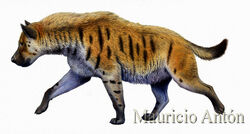
Reconstruction of the giant short-faced hyena (Pachycrocuta spp.) by Mauricio Antón. A number of Nandi bear sightings clearly refer to animals very much like giant hyenas.
Put forward by Karl Shuker,[39] the other main theory regarding the Nandi bear is that it is an unknown giant hyena, specifically a surviving descendant of the giant short-faced hyena (Pachycrocuta brevirostris), which is known to have lived in East Africa.[1]
Shuker notes that the short-faced hyena's muzzle made its profile more bear-like than that of a regular hyena, whilst the rest of its body was "indisputibly hyeanid", just larger and more robust. Fossil evidence also suggests that the short-faced hyena was both solitary and a more active hunter than the modern hyena.[9]
The footprints and "blood-curdling" howl of the animal which killed Captain Hichens' dog were similar to the tracks and calls of a hyena, and, as mentioned above, Roger Courtney also saw the tracks of what seemed to be a giant hyena. Modern hyenas also do sometimes badly maim the heads of their victims.[6] Bernard Heuvelmans noted that the tracks reported by Hichens and Courtney most closeley resembled those of an enormous hyena.[2] The "giant forest hyenas" reported from Kenya and connected with the Nandi bear by several authors were also obviously hyenas of some kind, not baboons or chalicotheres. The contemperory Chief Game Warden of Kenya, A. T. A. Ritchie, also believed the Nandi bear was some kind of giant hyena.[28]
Chalicothere[]
The third theory regarding the unknown animal behind the Nandi bear sightings, originally suggested by Charles William Andrews, and reported by Heuvelmans, is that it was a surviving species of African chalicothere.[2] These horse-sized animals, with sloping backs, bear-like heads, long claws, and short tails, agree very well with physical descriptions of the Nandi bear – and the forefeet of a chalicothere, with three toes and, in some species, inward-turned claws, would also be somewhat consistent with the "hyena-like" Nandi bear identified by Eberhart. Chalicothere fossils have been found in an area where chimiset attacks were reported, and Heuvelmans noted that if the okapi, a relative of certain giraffids contemporary to chalicotheres, could survive in Central Africa to the present day, there is little reason why a chalicothere couldn't.[2] A number of authors have also noted that rinderpest, which the Nandi said decimated chimiset populations at the end of the 19th Century, principally kills ungulates, not carnivores,[18][35][40] though if the Nandi bear were a carnivore, populations could have dropped due to the loss of food sources to rinderpest.
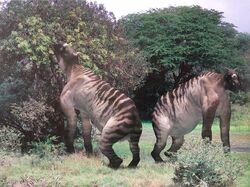
Ancylotherium, the latest known African chalicothere, as depicted in the BBC TV series Walking with Beasts. Chalicotheres match the Nandi bears appearance in many respects, but not its behaviour.
However, if the Nandi bear were a chalicothere, it could not be a vicious predator, as chalicotheres were certainly herbivorous,[2] which would make hyenas and ratels responsible the attacks blamed on the Nandi bear,[9] although Shuker notes that just because chalicotheres were herbivores, it does not mean they couldn't have been aggressive or dangerous.[6] The theory is also criticised by Dale A. Drinnon and others, on the basis of the Nandi bear's digit count, alleged cry, and behaviour.[41]
Supporters of the chalicothere theory include palaeoanthropologist Louis S. Leakey,[42] Karl Shuker, and chalicothere expert Christine Janis.[39][43]
Most known African chalicotheres are known only from the Miocene, the most common at the time being Butleria. One genus, Ancylotherium, is known to have survived into the Early Pleistocene, but it was a member of the chalicothere subfamily Schizotheriinae, and is believed to have resembled a horse more than a gorilla or hyena.[44] A Late Miocene genus of chalicothere discovered in Baringo County, Kenya in 1979 was named Chemositia,[44] presumably in recognition of the Nandi bear-chalicothere theory.
Creodont[]
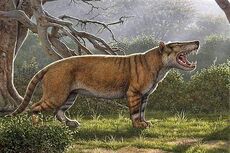
Reconstruction of the African creodont Simbakubwa by Mauricio Antón.
A very large fossil hyaenodont - a relatively bear-like, bone-crushing predator - from the Miocene named Simbakubwa (in 2019) was discovered but not described in 1978-1980 at a fossil bed named Meswa Bridge in Kisumu County, Kenya. Kisumu County is immediately south of Nandi County, and Karl Shuker notes that the discovery of the fossil in a site close to the location of several Nandi bear sightings is at least an interesting coincidence, and questions whether a living creodont descended from Simbakubwa, with a modified gait and morphology, should be added to the long list of putative Nandi bear identities.[45]
Bear[]
The Nandi bear is also sometimes speculated to be a true bear.[7] Dale A. Drinnon has suggested that the Nandi bear really was a bear, noting that the early sightings described an animal which sounded very much like a bear, and the animal's spoor somewhat resembles bear tracks. The Nandi bear's reported habit of killing with a swipe of its paws is similar to how bears fight. Bears were reported as living in Ethiopia in Roman times, and in 1668 O. Dapper wrote that bears were known to live in the Congo. Drinnon also discovered a "bear skull from Tanzania" for sale online in 2006, although it may actually have been a lion skull.[41]
Although no bears are confirmed to have inhabited sub-Saharan Africa in historical times (the Atlas bear being confined to North Africa), one large species, the "hyena bear" Agriotherium africanum did inhabit Kenya until as recently as the Early Pleistocene, about two and a half million years ago.[7] Shuker also lists a southern range of the Atlas bear as a possible identity.[35]
Heuvelmans did not believe the Nandi bear was an actual bear, as according to him all known bears "are remarkably evenly covered with fur",[note 3] and, although eyewitnesses described it as walking like a bear, nobody ever described is as ambling with the specific, unmistakable gait of a bear.[2] He later wrote that he found the possibility of a species of bear existing further south than Sudan and Ethiopia was "the peak of implausibility".[25]
Witch-doctors[]
Patrick Bowen suggested to Frank Lane that the Nandi bear was a scapegoat for native witch-doctors carrying out massacres. Heuvelmans noted that witch-doctors are skilled at imitating calls and tracks in order to steal cattle and revenge themselves on their enemies. He speculated about a secret society similar to the Aniota of Nigeria and the Congo, disguising their murders by faking tracks and killing people with clawed weapons.[2]
Similar cryptids[]
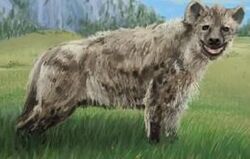
One modern-day cryptid with similarities to the Nandi bear is the Malawi terror beast.
Heuvelmans first equated the Nandi bear with the khodumodumo, a mystery predator reported from South Africa,[2] but he later theorised that this animal was a feline.[25] Karl Shuker suggests that the booaa, a large hyena reported from Senegal, may represent a far western range of the hyena-like version of the Nandi bear.[1] The Malawi terror beast, a large, man-eating, hyena-like animal reported from Malawi, also has some similarities with the Nandi bear. Patrick Bowen and Frank Lane theorised that attacks carried out by the mngwa, a definite feline animal, could be blamed on the Nandi bear.[25]
In popular culture[]
- The Nandi bear was the subject of a 2010 episode of Desination Truth, in which Josh Gates controversially concluded that the cryptid was a misidentified hyena.[46]
- The Nandi bear was featured in a Gold Key Comics' Tarzan #134 (March 1963), in a story called "The Hunting of the Beast," in which it is battled by Tarzan. Although portrayed as a bear-like animal (with long ears, like the ngoloko), it is referred to as a chalicothere.[47] This version of the Nandi bear also appeared in Gold Key Comics' Korak: Son of Tarzan #28 (April 1969), in which Korak rescues a race of miniature people from it.[48]
- The Nandi bear appears on card #29 of the Weird n' Wild "Monsters of the Mind" card set. Oddly, it is depicted as having only a single eye, like a cyclops, in the centre of its brow.
- The chemosit appears as a magical beast in the Pathfinder Roleplaying Game, where it is depicted as a 9' tall, half-ape-half-bear creature with black fur. Like the real Nandi bear, the chemosit is said to eat its victims brains, and to have a terrifying roar.[49]
Further cryptozoological reading[]
- Heuvelmans, Bernard (1955) On the Track of Unknown Animals
- Shuker, Karl (1995) In Search of Prehistoric Survivors
- Heuvelmans, Bernard & Grison, Benoit & Barloy, Jean-Jacques (2015) Les Ours Insolites d'Afrique
Notes and references[]
- ↑ There are a few cases of man-eating lions forcing their way through thorn zarebas, such as the famous Tsavo lions, whose pelts were covered in scars from breaking through the thorn walls.
- ↑ 2.0 2.1 2.2 2.3 Although Meinertzhagen's Nandi bear claims have never come under any scrutiny or been widely publicised, he is widely regarded as a liar in ornithological matters. The first sighting of the Nandi bear was not reported until 1912, yet Meinertzhagen represents himself as researching it - and claims that a Nandi soldier referred to it as the "Nandi bear" - as early as 1905.
- ↑ Indian sloth bears have manes around their faces. An illustration of Baloo, the sloth bear from The Jungle Book, was also identified as the 1905 Nandi bear by one eyewitness.
- ↑ 1.00 1.01 1.02 1.03 1.04 1.05 1.06 1.07 1.08 1.09 1.10 1.11 1.12 1.13 1.14 1.15 1.16 1.17 1.18 1.19 1.20 1.21 1.22 1.23 Eberhart, George M. (2002) Mysterious Creatures: A Guide to Cryptozoology, ABC-CLIO, Inc., ISBN 1576072835
- ↑ 2.00 2.01 2.02 2.03 2.04 2.05 2.06 2.07 2.08 2.09 2.10 2.11 2.12 2.13 2.14 2.15 2.16 2.17 2.18 2.19 2.20 2.21 2.22 2.23 2.24 2.25 2.26 2.27 2.28 2.29 2.30 2.31 2.32 Heuvelmans, Bernard (1955) On the Track of Unknown Animals, Routledge, ISBN 978-1138977525
- ↑ Hobley, C. W. "Unidentified Beasts in East Africa", Journal of the East Africa and Uganda Natural History Society 7 (1913)
- ↑ 4.0 4.1 4.2 4.3 Percival, A. Blayney "The Chemosit", Journal of the East Africa and Uganda Natural History Society 8 (1914)
- ↑ 5.0 5.1 5.2 Coleman, Loren & Clark, Jerome (1999) Cryptozoology A to Z: The Encyclopedia of Loch Monsters, Sasquatch, Chupacabras, and Other Authentic Mysteries of Nature, Simon & Schuster, ISBN 978-0684856025
- ↑ 6.0 6.1 6.2 6.3 6.4 Shuker, Karl P. N. (1995) In Search of Prehistoric Survivors: Do Giant 'Extinct' Creatures Still Exist?, Blandford, ISBN 9780713-724691
- ↑ 7.0 7.1 7.2 7.3 Shuker, Karl P. N. (2016) Still In Search Of Prehistoric Survivors: The Creatures That Time Forgot?, Coachwhip Publications, ISBN 978-1616463908
- ↑ Heuvelmans, Bernard "Annotated Checklist of Apparently Unknown Animals With Which Cryptozoology Is Concerned", Cryptozoology, No. 5 (1986)
- ↑ 9.0 9.1 9.2 9.3 Shuker, Karl P. N. (1997) From Flying Toads To Snakes With Wings, Bounty Books, ISBN 0-7537-1305-5
- ↑ 10.0 10.1 10.2 Shuker, Karl P. N. ShukerNature: DO BLACK RATELS AND ORANGE HYAENAS MAKETH THE NANDI BEAR? karlshuker.blogspot.com [Accessed 10 May 2019]
- ↑ 11.0 11.1 Hichens, William "On the Trail of the Brontosaurus: Encounters with Africa's Mystery Animals" Chamber's Journal (1927)
- ↑ 12.0 12.1 12.2 Hichens, William, "African Mystery Beasts" Discovery 18 (1937)
- ↑ Synge, Patrick M. "Some Notes on the Mountains of Uganda," The Uganda Journal 2 (October 1934)
- ↑ 14.0 14.1 14.2 14.3 Muirhead, Richard "Some Notes on the Nandi Bear," Flying Snake 1 (2011)
- ↑ "Settler Shoots Beast of Legend," The Hong Kong Telegraph (10 December 1936)
- ↑ 16.0 16.1 16.2 Someren, G. R. Cunningham van "The Nandi Bear", EANHS Bulletin (1982)
- ↑ 17.0 17.1 17.2 17.3 Meinertzhagen, Richard (1957) Kenya Diary 1902-1906
- ↑ 18.0 18.1 Pitman, Charles (1931) A Game Warden Among His Charges
- ↑ 19.0 19.1 19.2 Williams, Geoffrey "An Unknown Animal on the Uasingishu", Journal of the East Africa and Uganda Natural History Society 4 (1912)
- ↑ 20.0 20.1 20.2 20.3 20.4 Hobley, C. W. "On Some Unidentified Beasts", Journal of the East Africa and Uganda Natural History Society 6 (1913)
- ↑ Fishing, H. C. "Nandi Bear Again," East Africa and Uganda Natural History Society 70 (September 1941)
- ↑ Buxton, Cara "The 'Gadett' or Brain-Eater" The Journal of the East Africa and Uganda Natural History Society 13 (1918)
- ↑ 23.0 23.1 23.2 Newton, Michael (2009) Hidden Animals: A Field Guide to Batsquatch, Chupacabra, and Other Elusive Creatures, ABC-CLIO, ISBN 9780313359064
- ↑ 24.0 24.1 Courtney, Roger (1936) Africa Calling
- ↑ 25.0 25.1 25.2 25.3 Heuvelmans, Bernard & Rivera, Jean-Luc & Barloy, Jean-Jacques (2007) Les Félins Encore Inconnus d’Afrique, Les Editions de l'Oeil du Sphinx, ISBN 978-2914405430
- ↑ Murder that shaped the future of Kenya - The East African
- ↑ 27.0 27.1 27.2 27.3 27.4 Hickes, G. W. "Notes on the Unknown Beast Seen on the Magadi Railway" Journal of the East Africa and Uganda Natural History Society 6 (1913)
- ↑ 28.0 28.1 28.2 "Nandi "Bear" May be a Giant Hyena," The Singapore Free Press and Mercantile Advertiser (28 December 1927)
- ↑ 29.0 29.1 Report of the Game Department of the Colony and Protectorate of Kenya (1932-34)
- ↑ "Settler Shoots Beast of Legend," The Hong Kong Telegraph (10 December 1936)
- ↑ Copley, Hugh "Nandi Bear?," East Africa and Uganda Natural History Society 70 (September 1941)
- ↑ "Letters," Old Africa #29 (June 2010)
- ↑ 33.0 33.1 "The Strange Case of the Nandi Bear," SAFARI Magazine (October-November 1998)
- ↑ 34.0 34.1 Keeling, C. H., "The British Nandi Bear?," Animals & Men 6
- ↑ 35.0 35.1 35.2 35.3 Shuker, Karl P. N. ShukerNature: WHEN NANDI BEARS AND GROUND SLOTHS CAME TO TOWN? TWO EARLY EXHIBITIONS OF CRYPTIDS IN ENGLAND? karlshuker.blogspot.com [Accessed 10 May 2019]
- ↑ Huxley, Elspeth (1985) Out In The Midday Sun
- ↑ "Are Strange Animals Still to be Discovered?," Aberdeen Press and Journal (3 November 1937)
- ↑ Coudray, Philippe (2009) Guide des Animaux Cachés, Editions du Mont, ISBN 978-2915652383
- ↑ 39.0 39.1 Shuker, Karl P. N. "A Supplement to Dr Bernard Heuvelmans' Checklist of Cryptozoological Animals," Fortean Studies, Vol. 5 (1998)
- ↑ Shuker, Karl P. N. ShukerNature: NANDI BEARS AND DEATH BIRDS - MY TOP TEN DEADLIEST MYSTERY BEASTS !! karlshuker.blogspot.com [Accessed 10 May 2019]
- ↑ 41.0 41.1 Drinnon, Dale A. Frontiers of Zoology: Is The Nandi Bear Actually a Bear? frontiersofzoology.blogspot.com
- ↑ Leakey, Louis S. (1935) Does the Chalicothere, Contemporary of the Okapi, Still Survive?
- ↑ Shuker, Karl P. N. (2003) The Beasts That Hide From Man: Seeking the World's Last Undiscovered Animals, Paraview Press, ISBN 1-931044-64-3
- ↑ 44.0 44.1 Werdelin, Lars & Sanders, William Joseph (2010) Cenozoic Mammals of Africa
- ↑ Shuker, Karl "A Fossil Nandi Bear?," Fortean Times 380 (June 2019)
- ↑ Cryptomundo » DT: Nandi Bear
- ↑ Shuker, Karl P. N. ShukerNature: TARZAN AND THE NANDI BEAR karlshuker.blogspot.com [Accessed 10 May 2019]
- ↑ Shuker, Karl P. N. ShukerNature: TARZAN'S SON AND THE NANDI BEAR karlshuker.blogspot.com [Accessed 10 May 2019]
- ↑ Hitchcock, Tim (2010) Pathfinder Adventure Path #38: Racing to Ruin

